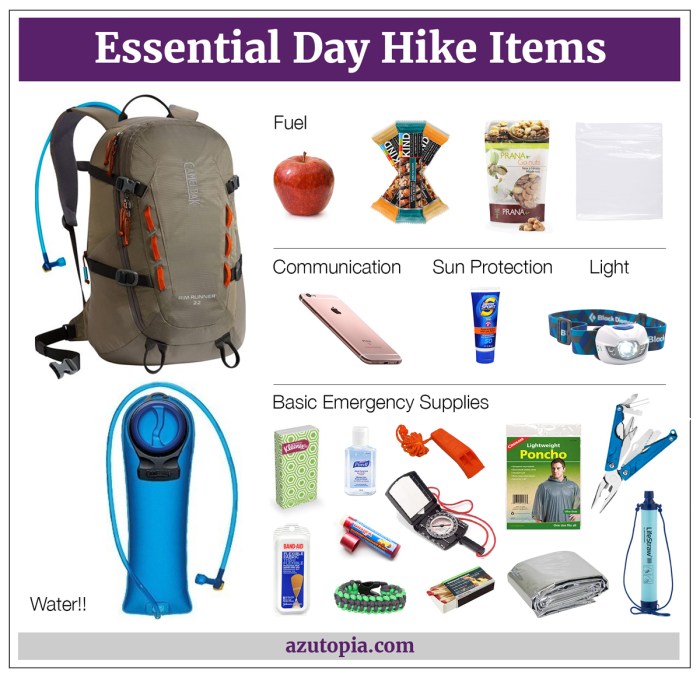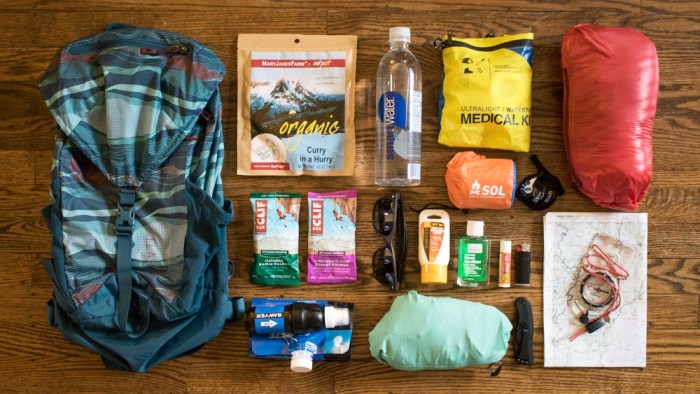Kicking off with hiking essentials, this guide is all about getting you ready for the trails. From must-have items to packing tips, we’ve got you covered for your next outdoor adventure.
Whether you’re a beginner or a seasoned hiker, knowing what essentials to bring can make or break your trip. Let’s dive in and make sure you’re fully prepared for whatever the wilderness throws your way.
Hiking Essentials Checklist

When preparing for a hiking trip, having the right gear can make all the difference in your comfort and safety. Here is a checklist of must-have items to ensure a successful hike:
- Hiking Boots: Proper footwear is essential to prevent blisters and provide ankle support on rough terrain.
- Backpack: A sturdy backpack with padded straps and multiple compartments is necessary to carry all your gear comfortably.
- Water Bottle: Staying hydrated is crucial, so always pack a reusable water bottle or hydration system.
- Map and Compass: In case you lose your way or encounter poor GPS signal, having a map and compass can help you navigate safely.
- First Aid Kit: Accidents can happen on the trail, so a well-stocked first aid kit is essential for treating minor injuries.
- Snacks: Pack energy-boosting snacks like nuts, trail mix, or energy bars to keep you fueled throughout the hike.
Tips on Prioritizing Items
When deciding what to pack for your hike, consider the type of terrain, weather conditions, and duration of the hike. Here are some tips on how to prioritize items based on these factors:
- For a short day hike on well-marked trails, focus on essentials like water, snacks, and a first aid kit.
- For longer hikes or hikes in remote areas, prioritize navigation tools like a map and compass, as well as extra clothing layers in case of changing weather.
- In challenging terrain or unpredictable weather, sturdy hiking boots and proper rain gear should be at the top of your list.
Backpack Selection
When it comes to choosing the right hiking backpack, there are a few key features to consider. First off, you’ll want to look at the size of the backpack and make sure it can comfortably hold all your gear. Additionally, consider the material of the backpack to ensure it is durable and water-resistant. Look for padded shoulder straps and a hip belt for added comfort during long hikes. Lastly, check for extra features like multiple compartments, hydration bladder compatibility, and adjustable straps for a customized fit.
Different Sizes and Styles
When it comes to backpack sizes, there are typically three main categories: daypacks, overnight packs, and multi-day packs. Daypacks are smaller and perfect for short hikes or day trips. Overnight packs are slightly larger and can hold enough gear for an overnight stay. Multi-day packs are the largest and are designed for longer hikes that span multiple days. Choose the size that best fits your hiking needs.
Efficient Packing Tips, Hiking essentials
Packing efficiently for different durations of hikes is crucial to ensure you have everything you need without carrying unnecessary weight. Start by organizing your gear into categories like clothing, food, and safety essentials. Use packing cubes or stuff sacks to keep items organized and easily accessible. Remember to distribute weight evenly in your backpack and pack heavier items closer to your back for better balance. Don’t forget to pack your essentials like a map, compass, first aid kit, and extra layers for changing weather conditions.
Footwear for Hiking
When it comes to hiking, having the right footwear is crucial for a successful and comfortable trek. Proper hiking footwear provides support, stability, and protection for your feet, helping to prevent injuries and discomfort along the trail.
Differences between Hiking Boots, Shoes, and Trail Runners
- Hiking Boots: Hiking boots are sturdy and provide excellent ankle support, making them ideal for rough terrain and carrying heavy loads. They are a great choice for longer hikes and backpacking trips.
- Hiking Shoes: Hiking shoes are lighter and more flexible than boots, offering a balance between support and agility. They are suitable for day hikes and less demanding trails.
- Trail Runners: Trail runners are lightweight and designed for speed and agility on well-maintained trails. They are a good option for those looking to move quickly and cover a lot of ground.
Tips for Breaking in New Hiking Footwear
- Start Slow: Wear your new hiking footwear around the house or on short walks to gradually break them in and identify any areas of discomfort.
- Use Thick Socks: Wear thick hiking socks to help cushion your feet and reduce friction while breaking in your new footwear.
- Adjust Lacing: Experiment with different lacing techniques to find the most comfortable fit and prevent blisters on the trail.
- Apply Moleskin: If you feel any hot spots or friction points, apply moleskin or blister pads to prevent blisters from forming.
Clothing for Hiking: Hiking Essentials
When it comes to hiking, choosing the right clothing is crucial for your comfort and safety on the trails. The key is to dress in layers, so you can easily adjust to changing weather conditions and your activity level.
Layering Techniques
Layering is essential for hiking, as it allows you to regulate your body temperature and stay comfortable throughout your trek. Here are the basic layering techniques for different weather conditions:
- Base Layer: Choose moisture-wicking fabrics like merino wool or synthetic materials to keep sweat away from your skin.
- Insulating Layer: Add a fleece or down jacket to provide warmth in colder conditions.
- Outer Shell: A waterproof and windproof jacket will protect you from rain and harsh winds.
Best Fabrics for Hiking Clothing
When selecting clothing for hiking, opt for fabrics that are breathable, lightweight, moisture-wicking, and quick-drying. Some of the best fabrics for hiking clothing include:
- Merino Wool: Naturally wicks away moisture and regulates body temperature.
- Synthetic Fabrics: Polyester and nylon blends are durable, quick-drying, and provide good moisture management.
- GORE-TEX: A waterproof and breathable material that keeps you dry in wet conditions.
Choosing the Right Clothing
The clothing you choose for hiking should be based on the season and terrain you will be trekking through. Consider the following tips when selecting your hiking attire:
- Summer Hiking: Opt for lightweight and breathable clothing to stay cool and comfortable.
- Winter Hiking: Dress in layers with insulating materials to stay warm in cold temperatures.
- Mountain Hiking: Wear moisture-wicking fabrics and pack a waterproof jacket for unpredictable weather conditions.
Navigation Tools

When heading out for a hike, it’s crucial to have the right navigation tools to ensure you stay on track and reach your destination safely. Here are some essential tools to consider:
Map and Compass
Using a map and compass is a traditional but reliable way to navigate while hiking. Here’s how to use them effectively:
– Orient the map to match the terrain around you.
– Use the compass to determine which direction you’re facing and where you need to go.
– Follow the map’s key features like trails, rivers, and mountain peaks to stay on course.
GPS Devices and Smartphone Apps
GPS devices and smartphone apps have become popular tools for navigation in the outdoors. Here are some insights on using them:
– GPS devices provide accurate location data and can track your route.
– Smartphone apps like Gaia GPS or AllTrails offer detailed trail maps and real-time tracking.
– Remember to bring extra batteries or a portable charger for electronic devices to avoid running out of power.
First Aid Kit
When hiking, it’s crucial to have a well-equipped first aid kit to handle any injuries or emergencies that may arise on the trail. Here are some essential items to include in your hiking first aid kit:
Essential Items for a Hiking First Aid Kit
- Adhesive bandages in various sizes
- Gauze pads and adhesive tape
- Antiseptic wipes or alcohol pads
- Tweezers and scissors
- Pain relievers like ibuprofen or acetaminophen
- Antihistamine for allergic reactions
- Moleskin for blisters
- Emergency blanket
- Triangular bandage for splinting
Handling Common Hiking Injuries and Emergencies
- If you encounter a blister, clean the area, apply moleskin, and try to reduce friction.
- For minor cuts and scrapes, clean the wound, apply an antiseptic, and cover with a bandage.
- In case of a sprain or strain, rest the affected area, apply ice if available, compress with a bandage, and elevate.
- If someone is experiencing heat exhaustion, move them to a cool place, hydrate, and loosen clothing.
Customizing a First Aid Kit
- Consider any specific health conditions or allergies you may have when customizing your kit.
- Include any personal medications or supplies you may need while hiking.
- Add items like an EpiPen for severe allergic reactions if necessary.
Hydration and Nutrition
Staying hydrated and well-nourished is crucial when hitting the trails for a hike. Proper hydration ensures you have the energy and endurance needed to tackle the varying terrains, while good nutrition provides the fuel your body needs to keep going.
Importance of Staying Hydrated
- Hydration helps regulate body temperature and prevent dehydration, especially in hot weather or high altitudes.
- Drinking enough water maintains muscle function and prevents fatigue.
- Proper hydration can improve focus and cognitive function, essential for navigating trails safely.
Calculating Water Needs
- General rule: Drink about half a liter (17 ounces) of water per hour of moderate activity.
- Consider factors like temperature, humidity, and intensity of the hike when calculating water needs.
- Carry a water bottle or hydration reservoir and refill at designated spots along the trail.
Trail Snacks and Meals
- Choose lightweight, high-energy snacks like nuts, dried fruits, energy bars, or trail mix for quick boosts of energy.
- Pack meals that are easy to carry, like sandwiches, wraps, or dehydrated meals that only require adding water.
- Include a balance of carbohydrates, proteins, and fats to sustain energy levels during long hikes.
Safety Precautions
When it comes to hiking, safety should always be a top priority. Taking the necessary precautions can help ensure a smooth and enjoyable outdoor adventure. Here are some safety measures to consider before and during a hike, along with tips on how to handle unexpected situations on the trail and how to hike responsibly to leave no trace.
Pre-Hike Safety Measures
- Check the weather forecast before heading out and dress accordingly.
- Inform someone of your hiking plans, including your route and expected return time.
- Pack essential items like a map, compass, flashlight, whistle, and extra food and water.
- Ensure your gear is in good condition and pack a basic first aid kit.
During-Hike Safety Tips
- Stay on marked trails and avoid taking unnecessary risks.
- Stay hydrated and take breaks as needed to prevent exhaustion.
- Be aware of your surroundings and watch out for wildlife.
- Follow Leave No Trace principles by packing out all trash and respecting wildlife and other hikers.
Handling Unexpected Situations
- If you get lost, stay calm, and try to retrace your steps or signal for help using a whistle or mirror.
- In case of injury, assess the situation, administer first aid if needed, and call for help if necessary.
- If you encounter wildlife, maintain a safe distance, avoid feeding them, and make noise to alert them of your presence.
Hiking Responsibly
- Respect wildlife and natural habitats by observing from a distance and not disturbing the environment.
- Stay on designated trails to avoid damaging vegetation and causing erosion.
- Pack out all trash, including biodegradable items like food scraps and toilet paper.
- Educate yourself on Leave No Trace principles and strive to minimize your impact on the environment.